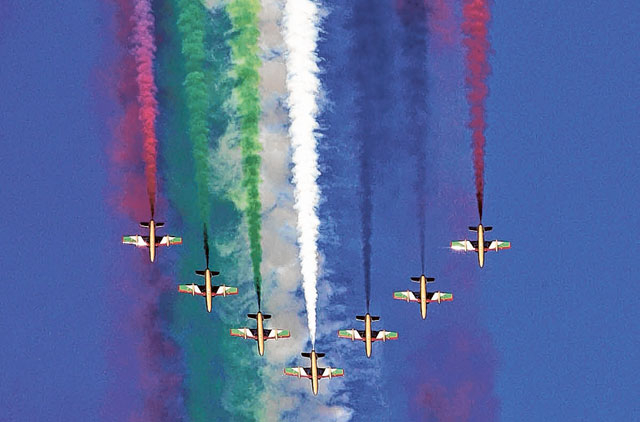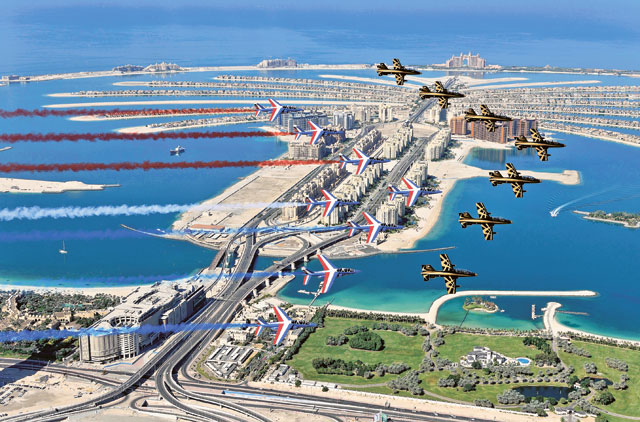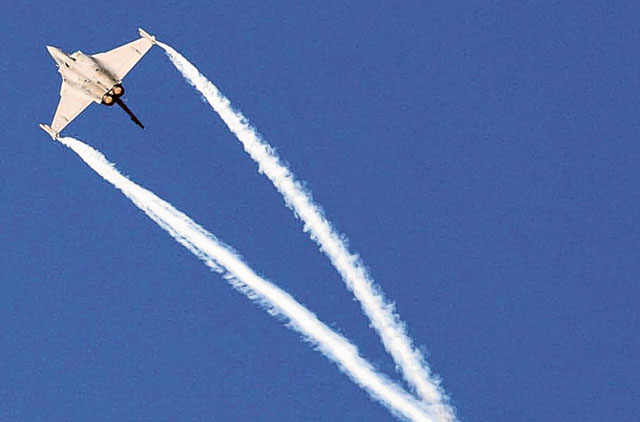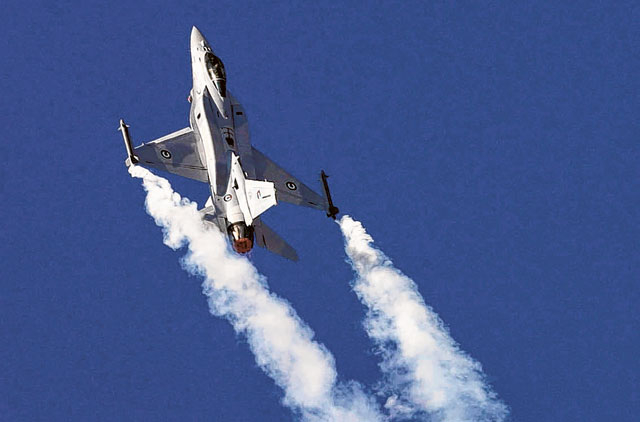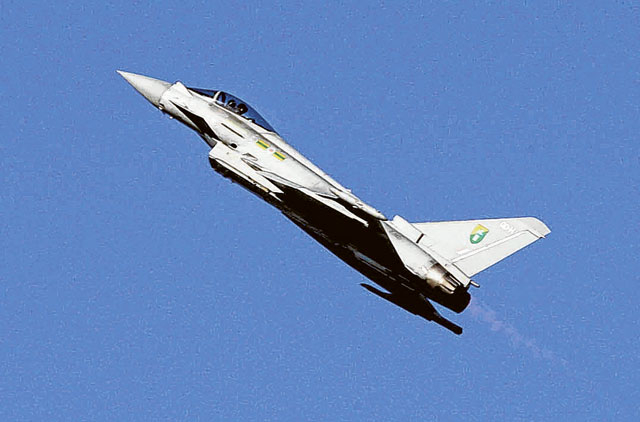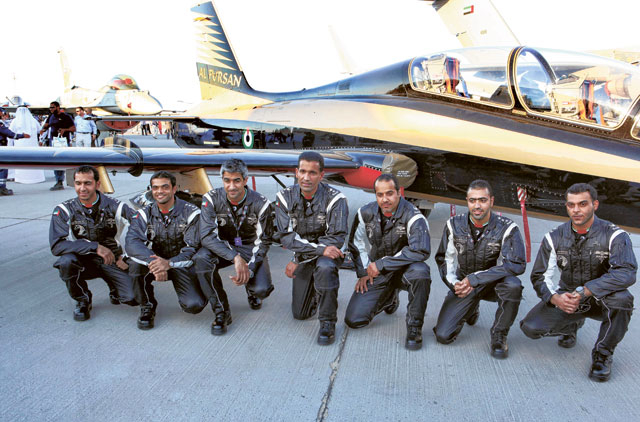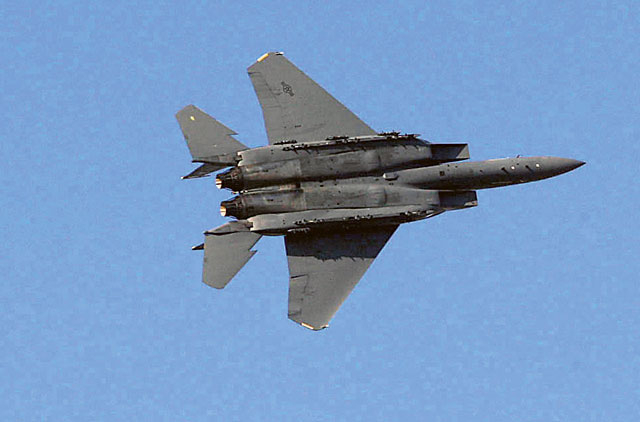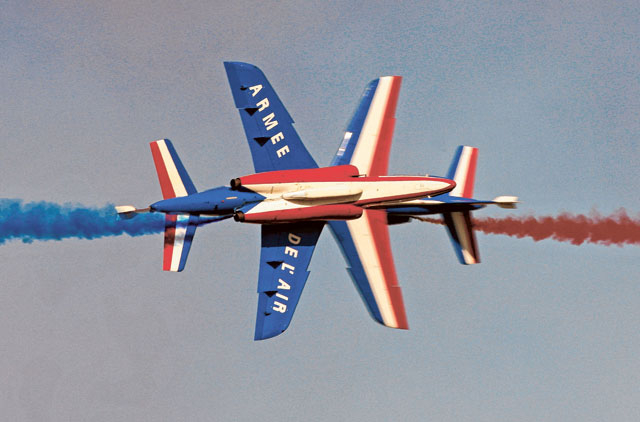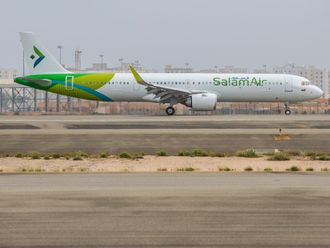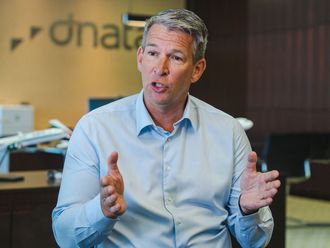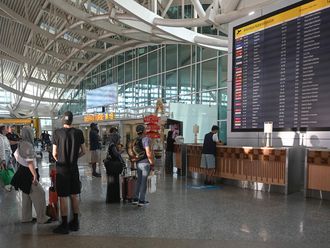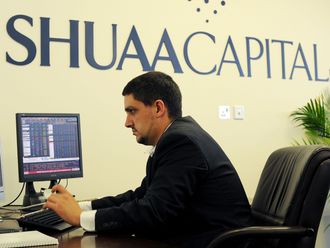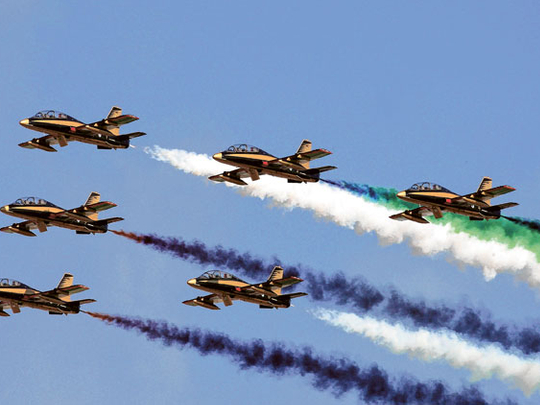
Dubai: The world's most talented performers almost always make impossible feats look effortless.
Aerobatic pilots at the Dubai Airshow were no exception yesterday as they etched a rainbow of coloured smoke across the skies, wowing audiences far below in a wash of deafening jet-engine thunder.
But for all the graceful air ballet choreographed over Dubai's skyline, few spectators could ever imagine the mind-bending, body-numbing punishment imposed on pilots during their death-defying aerobatics.
Despite intensive training to buffer the exertion required to fly free from the bonds of earth at breakneck speeds, Mother Nature serves up a menacing assault on bodily senses for those who dare to reach for the sky in such dramatic fashion.
With an estimated top speed of Mach 2.5 (2,660 km/h), one of the stars at this year's show was the F-15E Strike Eagle jet fighter which mesmerised neck-craned visitors as it screamed to show centre and its USAF flight crew then punched the throttle for a vertical push straight up into the blue yonder.
American pilot Paul Knapp has logged 1,500 hours of flying time since his first flight as a cadet in 1989 in the Boeing F-15E Strike Eagle, one of the meanest all-weather twin turbo-engine jet fighters in the world.
While some may falsely assume that today's technology makes aircraft as easy to fly as they are graceful to watch, the Boeing test pilot and weapons systems operator told Gulf News in the human crush of the Dubai Airshow that the natural forces of gravity foist formidable forces upon the body of the F-15E pilot during unearthly acceleration. The vertical climb into the heavens is anything but a casual weekend drive to Grandma's.
"It is physically gruelling," Knapp said. "During the Airshow, the air crew is max performing the airframe. When you do that, you also max perform the body as well. There are a couple of times during the Airshow when they are pulling some heavy gravity."
For example, at yesterday's final aerial acrobatic show, the F-15E USAF flight crew, based at Seymour Johnson Airbase in North Carolina, pushed their aircraft horizontally to an estimated speed of 400 knots (740.8 km/h) before pulling the nose of the aircraft upward at the base of the vertical climb.
"When they are going to show centre and doing a max vertical, it's on that turn when you experience 9Gs," Knapp said, adding that the pilot also experiences the same mind and body-altering G-forces in reverse as the plane nears the conclusion of its vertical dive back toward terra firma.
Knapp explained that 9Gs (g is for gravity) may sound like some fancy flyboy lingo but in reality the weight of that much gravity can be crushing — and fatal — for someone who hasn't properly trained to absorb the all-over body drubbing.
To understand a G, Knapp said, 1G is the base measurement which we all experience on the ground while walking or working. A fast race car such as the Bugatti Veyron may pull 1.5Gs as it accelerates rapidly. Shuttle astronauts experience 3Gs while a dragster driver might pull 4Gs.
But it's not the G forces on their own merit that threaten jet fighter pilots, Knapp said, it's the extreme ensuing effects of gravity on the entire body as blood rushes to the feet, draining the upper body and brain of blood and risking loss of consiousness which, for a pilot in the cockpit of a $30-million aircraft, is unfathomable.
With each doubling of Gs (from 1G to 2G, for example) the weight of the pilot also theoretically doubles and correspondingly, it becomes increasingly difficult to move your arms and legs in a way very similar to failed attempts to reshift your weight on a super fast roller coaster ride.
In short, if a pilot weighs 100kg and is pushing 9Gs, in that moment such as the beginning of the vertical climb in the F-15E, the pilot feels as if he weighs 900kg. To compensate and keep everything under control, pilots wear G-suits which compress the legs and lower body to keep blood in the head and thereby avoid disastrous grey-outs or blackouts.
Head factor
That still leaves the pilot's head bobbing about which is also a big factor given that the average human head weighs about 8.2kg. When pulling 9Gs, a pilot feels as if his or her head weighs about 73.8kg (think seven, 10kg bags of potatoes) leaving it next to impossible to turn their head left or right in heavy turns.
Pilots learn early in training to place their head in the desired position in advance of the prescribed action of the aircraft so that the head is already in the right place when G forces are in full effect after moving the stick.
Captain Stephane Azou, of the world famous aeronautical acrobatic team Patrouille De France, said that coping with gravity is only the beginning of the steep learning curve cadet pilots must conquer.
Pilots of the eight-member French team have their hands full when performing intricate formation flying given that the tips of the wings are in extremely close proximity at any given time in their performances such as those witnessed this week in Dubai.
Unlike solo acrobatics and the accompanying ample airspace to manoeuvre, in extremely tight formation aeronautics, one wrong move in the thick of the team's red, white and blue Alphajet trainer aircraft pattern could invite certain calamity for more than just the offending pilot. "It's all about team spirit. The pilots fly at two to three metres apart at 600 km/h" Azou told Gulf News. "It is very dangerous."
Of course, pilot skill is still paramount given the multi-tasking required during the 22-minute aerial displays, Azou said.
Unlike standard aircraft operation which uses a stick-like steering device — forward to descend, backward to ascend — Patrouille De France's new trainees are inducted into a completely different way of precision formation flying that uses tiny trim buttons on the stick to stay in formation while airborne.
With each flick of a button or calculated roll of a dial, the aircraft moves ever so slightly.
"This is very special precision flying," he said. "They have to learn this because it is completely different. Pilots are performing 200 per cent concentration when they fly."
There are other tasks to be done simultaneously such as following the verbal instruction of the team leader in flight and blowing smoke trails while constantly maintaining a standard two- or three-metre safe zone from planes adjacent in the formation, Azou said.
"They have to be totally synchronised."
Keeping a close eye on personal space is a personal mantra not lost on the seven pilots of the new Al Fursan (The Knights) UAE aerobatic squadron which flew its maiden public performance on the first day (November 13) of the Dubai Airshow. Packing 4,000 pounds of thrust each from 632-43 Rolls Royce jet engines, the squadron's Aermacchi MB-339 aircraft — Italian jet trainers — dazzled visitors throughout the week with bold skywriting images across the sky streamed from wing tips.
Team leader Lt Col P.I.T. Nasser Al Obaidly told Gulf News that the newly-graduated team members have logged hundreds of hours in training this year in anticipation of their inaugural showing and have worked hard to grasp the fine art of formation flying.
"It's not an easy thing flying so close," Al Obaidly said in an interview at the team's ground display, flanked by fellow pilots all dressed in black flying suits befitting The Knights monicker. "It's hard work but we enjoy it."
Al Obaidly didn't discount that formation flying is dangerous work.
They're also routinely pulling serious gravity in tight heavy turns.
"We're pulling anywhere between 4Gs and 5Gs," he said, adding that as the team logs more air time they are getting a little more accustomed to the physical side effects of gravitational pull.
"We're getting used to the Gs."
Maintaining a vigilant never-waning guard while flying can take its mental and physical toll on talented Knight riders first among a privileged group that made UAE history this week.
The hardest part, Al Obaidly said, "is the concentration. It's like running 10 kilometres, when you land, you are perspiring."


